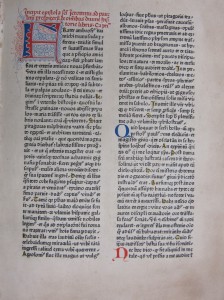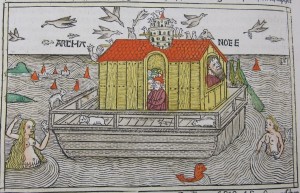For a University the size and age of Leicester the Library has a surprising rich collection of incunabula (books printed before 1501). The invention of the printing press during the 15th century saw the beginning of mass production and mass circulation of texts and images across Europe.
Our earliest printed work dates from the very early period of printing and provides us with a link to Johannes Gutenberg, whose invention of a printing press that used moveable type revolutionised book production in the mid-15th century. The book is a Latin Bible from the press of Heinrich Eggestein (c. 1415 – c. 1483) and was produced just over a decade after Gutenberg’s famous 1454-55 Bible, the first major book to be printed using the new technology. Eggestein is thought to have learned his trade from Gutenberg before establishing his own workshop in Strasbourg in 1465 from which he made a small fortune printing Latin Bibles.
The Library’s copy of Eggestein’s 1466 Vulgate Bible was bequeathed to Leicestershire and Rutland University College by Caleb Robjohns (c. 1857 – 1929), a hosiery manufacturer whose father was minister of Narborough Congregational Chapel. Many of the Library’s impressive collection of late medieval and early modern Bibles and other religious works were donated by Robjohns, who was an obsessive bibliophile. A bachelor, he lived with a housekeeper who became so infuriated with the number of books he brought into the house she threatened to leave. In order to pacify the housekeeper but maintain his hobby, he took to throwing parcels of books over the garden wall and heading out under cover of darkness to retrieve them and place them on his shelves.
Robjohns’s collection also included works from the presses of Anton Koberger (1440-1513) of Nuremberg, including a copy of his German Bible from 1483. Koberger is said to have employed over 100 craftsmen and owned 24 presses. Like many incunabula Koberger’s Bible incorporates woodcut illustrations that were printed with the text and then coloured manually after printing.
Koberger’s most famous publication was Hartmann Schedel’s Nuremberg Chronicle, of which the Library has an original copy published in 1493.The Chronicle is regarded as the most sophisticated printed book published before 1500 due to the different layouts integrating text and image in more ambitious ways than had been attempted previously. The many detailed and impressive woodcuts that illustrate the work were produced under the supervision of Michael Wohlgemut (1434-1519) and his stepson Wilhelm Pleydenwurff (c. 1450-1494). There is a link, here, to the famous Albrecht Dürer (1471-1528), godson of Koberger and apprentice to Wohlgemut between 1486 and 1489.
![Woodcut from Hartmann Schedel, Liber Chronicarum [Nuremberg Chronicle] (Nuremberg, 1493) (SCD 00390)](https://staffblogs.le.ac.uk/specialcollections/files/2014/04/NurembergChronicle-300x266.jpg)
Woodcut from Hartmann Schedel, Liber Chronicarum [Nuremberg Chronicle] (Nuremberg, 1493) (SCD 00390)




 Subscribe to Simon Dixon's posts
Subscribe to Simon Dixon's posts
[…] tutor groups to Special Collections to work with a selection of our medieval manuscripts, incunabula, vernacular Bibles, and other books from the Reformation period. Students received a short […]
[…] across the centuries. It came to the University as part of the Robjohns bequest, mentioned in an earlier blog post. I’m no expert when it comes to dating binding, but the leather binding with (now worn) gold […]